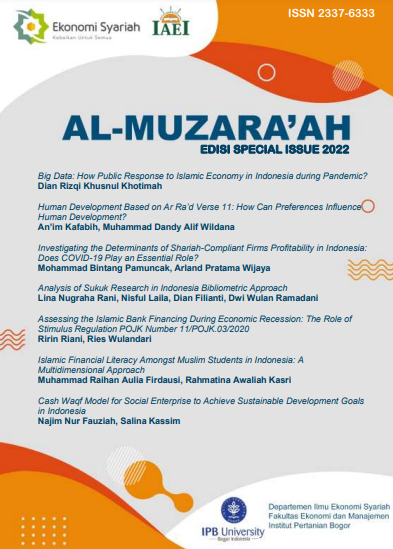Analysis of Sukuk Research in Indonesia Bibliometric Approach
Main Article Content
Abstract
The concept of sharia-based finance is currently growing rapidly in Indonesia. One form of sharia financial instrument that has been issued by both corporations and the state is the sukuk. Sukuk is one of the most innovative forms of product in the development of the contemporary sharia financial system. It can be concluded that sukuk is an alternative source of funding, especially for the government and corporate companies. The growth of sukuk in Indonesia has increased sharply compared to other Islamic financial instruments, the growth reaching 84% per year if analyzed from 2001 to 2007. Thus, sukuk has developed into one of the most important mechanisms in increasing finance in the international capital market through an Islamically acceptable structure. This study aims to determine the development of research trends in sukuk in Indonesia published by leading journals on Islamic financial economics. The data analyzed consisted of 47 papers that Scopusindexed research publications. The data is then processed and analyzed using the VOSviewer application to find out the bibliometric map of the development of sukuk research in Indonesia.
Article Details
Section
Author(s) who published in this journal agree to following terms:
- Authors understand and agree that copyright of manuscripts published are held by Al-Muzara'ah. The statement to release the copyright to Al-Muzara'ah is stated in Copyright Transfer Agreement (CTA) form.
- Copyright encompass exclusive rights to reproduce, to distribute, and to sell any part of the journal articles in all form and media.
This work is licensed under a Creative Commons Attribution-ShareAlike 4.0 International License (CC BY-SA) where Authors and Readers can copy and redistribute the material in any medium or format, as well as remix, transform, and build upon the material for any purpose, but they must give appropriate credit (cite to the article or content), provide a link to the license, and indicate if changes were made. If you remix, transform, or build upon the material, you must distribute your contributions under the same license as the original.
References
Adam, N. J. & Thomas, A. (2004). Islamic Bonds: Your Guide to Issuing, Structuring and Investingin Sukuk. London (UK), Euromoney Books.
Afshar, T. A. (2013). Compare and contrast sukuk (Islamic bonds) with conventional bonds, are they compatible?. Journal of Global Business Management, 9(1), 44-52.
Ahmed, E. R., Islam, M. A. & Alabdullah, T. T. Y. (2014). Islamic sukuk: Pricing mechanism and rating. Journal of Asian Scientific Research, 4(11), 640-648.
Al-Barwary, S. M. I. (2007). Pasar Modal Menurut Pandangan Islam. Kuala Lumpur (MY), Jasmin Enterprise.
Atika, A., Saraswati, D., Chrisna, H., Nasution, H. A. P., & Buana, S. P. (2018). Sukuk Fund issuance on sharia banking performance in Indonesia. International Journal of Civil Engineering and Technology, 9(9), 1531-1544.
Ayub, M. (2007). Understanding Islamic Finance. London (UK), Wiley.
Azhgaliyeva, D., Kapoor, A. & Liu, Y. (2020). Green bonds for financing renewable energy and energy efficiency in South-East Asia: a review of policies. Journal of Sustainable Finance & Investment, 10(2), 113-140.
Bhuiyan, R. A., Rahman, M. P., Saiti, B., & Ghani, G. M. (2018). Financial integration between sukuk and bond indices of emerging markets: Insights from wavelet coherence and multivariate-GARCH analysis. Borsa Istanbul Review, 18(3), 218-230.
Bhuiyan, R. A., Rahman, M. P., Saiti, B., & Ghani, G. M. (2019). Co-movement dynamics between global sukuk and bond markets: New insights from a wavelet analysis. International Journal of Emerging Markets, 14(4), 550-281.
[DSN MUI] Dewan Syariah Nasional Majelis Ulama Indonesia. (2003). Himpunan Fatwa Dewan Syariah Nasional. Jakarta (ID), Bank Indonesia.
Fasa, M. I. (2016). Sukuk: Teori dan Implementasi. Li Falah: Jurnal Studi Ekonomi dan Bisnis Islam, 1(1), 80-94.
Fatah, D. A. (2011). Perkembangan obligasi syariah (sukuk) di indonesia: Analisis peluang dan tantangan. Al Adalah, 10(1), 35-46.
Fauzi, F., Foo, D. & Basyith, A. (2017). Islamic bond announcement: Is there any effect on returns?. Global Business Review, 18(2), 327-347.
Iqbal, Z., & Mirakhor, A. (2011). An Introduction to Islamic Finance: Theory and Practice. New Jersey (US), John Wiley & Sons.
Muhammad, A. B. A. (2000). Mu’jam Al Mustholahaat Al Iqtishodiyah Wal Islamiyah. Riyadh (SA), Maktabah Al‘Abikan.
Muharam, H., Anwar, R. J. & Robiyanto, R. (2019). Islamic stock market and sukuk market development, economic growth, and trade openness (the case of Indonesia and Malaysia). Business: Theory and Practice, 20, 196-207.
Nagano, M. (2016). Who issues Sukuk and when?: An analysis of the determinants of Islamic bond issuance. Review of Financial Economics, 31, 45-55.
Nagano, M. (2017). Sukuk issuance and information asymmetry: Why do firms issue sukuk?. Pacific-Basin Finance Journal, 42, 142-157.
Nazaruddin, A. W. (2010). Sukuk: Memahami dan Membedah Obligasi pada Perbankan Syariah. Yogyakarta (ID), Ar-Ruzz Media.
Royani, Y., Bachtar, M. A., Tambunan, K., Tupan, T., & Alm, S. (2013). Pemetaan karya tulis ilmiah LPNK: Studi kasus LIPI dan BPPT (2004-2008). Jurnal Dokumentasi dan Informasi, 34(1), 1-28.
Shanmugam, B. and Zahari, Z.R. (2009). A Primer on Islamic Finance. Virginia (US), The Research Foundation of CFA Institute.
Siswantoro, D. (2012). Is “not‐real” price lawful?: The case of Islamic (sukuk) mutual funds in Indonesia during financial crisis. Journal of Islamic Accounting and Business Research, 3(2), 163-177.
Suryomurti, W. (2011). Supercerdas Investasi Syariah. Jakarta (ID), Qultum Media.
Tariq, A. A. (2004). Managing Financial Risks of Sukuk Structures. Loughborough (UK), Loughborough University.
Venardos, A. M. (2010). Current issues in Islamic banking and finance: Resilience and stability in the present system. World Scientific.
Yaumudin, U. K. (2008). Sukuk: Sebuah Alternatif Instrumen Investasi. Yogyakarta (ID), Kreasi Wacana.
Zubair, M. K. (2012). Obligasi dan sukuk dalam perspektif keuangan Islam: Suatu kajian perbandingan. Jurnal Ilmu Syari’ah dan Hukum, 46(1), 271-296.

